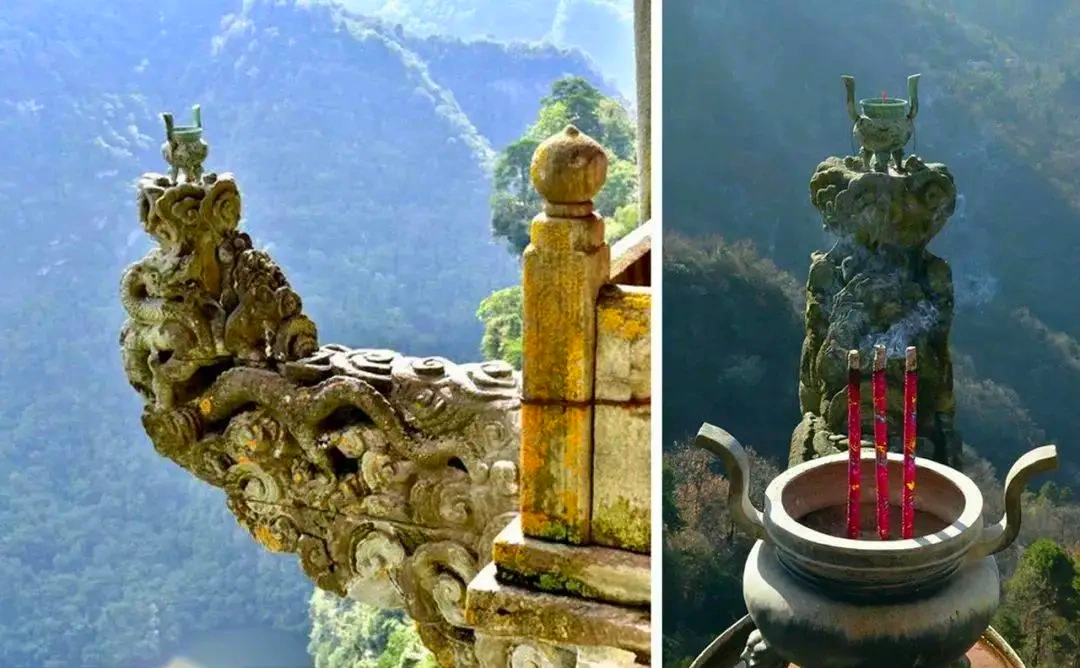
Dragon Head Incense of Wudang Mountain
The Dragon Head Incense (龙头香), also known as Longshou Stone (龙首石), is located in the Wudang Mountain Scenic Area (武当山风景名胜区), Hubei Province, China. Positioned in front of the Two Yi Hall (两仪殿) on the southern cliff of Wudang Mountain (武当山), it is a unique and iconic site known as the “World’s First Incense” (天下第一香). The Dragon Head Incense consists of a sculpted stone dragon, which stretches across a narrow stone beam suspended above a precipice. This breathtaking structure is believed to symbolize a link between the human world and the divine.
Overview
The Dragon Head Incense is an intricately carved stone sculpture, depicting two dragons merging into one, devouring a fireball. Above their heads is a stone incense burner, and the direction of the dragons’ heads points towards the Golden Summit (金顶) of Wudang Mountain. The entire structure extends 2.9 meters over the cliff, with a width of only 30 centimeters, creating a dramatic, precarious design. There are no railings, and the structure hangs in mid-air over a sheer rock face, making it a dangerous yet awe-inspiring sight.
The Dragon Head Incense was constructed in 1314 during the Yuan Dynasty (元朝延祐元年) and has long been a site of pilgrimage. Devotees used to climb the narrow path along the dragon’s body to offer incense, a dangerous practice that resulted in numerous fatalities due to the precarious position of the incense burner. In 1673, Emperor Kangxi (清康熙) of the Qing Dynasty (清朝) banned the burning of incense at the site, placing a stone monument to commemorate the prohibition.
Construction and Design
The Dragon Head Incense is a remarkable example of ancient craftsmanship, using a combination of round carving, relief carving, and shadow carving techniques to form two dragons. The dragons are depicted as if they are preparing to leap into the sky, creating a dynamic and powerful visual effect. The stone beam they rest on stretches out over a sheer cliff, creating the illusion that the dragons are soaring into the heavens.
According to legend, the dragons are the imperial steeds of the True Martial Emperor (真武大帝), who would often ride them to patrol the realms. The entire structure is designed to reflect the emperor’s divine authority and the powerful symbolism of the mountain.
Pilgrims and Tradition
The Dragon Head Incense has long been a site of religious significance, attracting pilgrims who wish to demonstrate their devotion by offering incense in this dangerous location. Traditionally, pilgrims would kneel and crawl along the narrow stone beam, carefully reaching the incense burner at the dragon’s head. After lighting the incense, they would retreat back in the same manner, risking their lives as they navigated the perilous path.
The incense offerings were believed to bring blessings, but the risks involved were extreme. Over the centuries, numerous devotees have fallen from the cliff to their deaths, making the site infamous for its danger. The practice was eventually prohibited in 1673 by the Qing Dynasty (清朝) Governor of Sichuan and Huguang, Cai Yirong (蔡毓荣), after the government recognized the danger to life. A monument was erected to remind people of the hazards of attempting to burn incense at such a height, emphasizing the value of life over reckless devotion.
Historical Records
In 1673, the Qing Emperor Kangxi (清康熙) issued an edict prohibiting incense offerings at Dragon Head Incense. The accompanying inscription on the stone monument warned people that the gods are merciful and that true devotion does not require placing oneself in danger. The inscription reads:
“Below the southern cliff, a temple was built to honor the spirits, with a stone dragon’s head carved from the cliff. The incense burner was placed there, overlooking the abyss. The incense burners who fell would meet their demise. This is a worldly act of folly, not a divine favor. We have moved the incense burner inside the temple to prevent further accidents. Let this serve as a lesson: do not risk your life in pursuit of incense offerings. This is the command of the governor, dated the first day of June, the eleventh year of Kangxi.”













